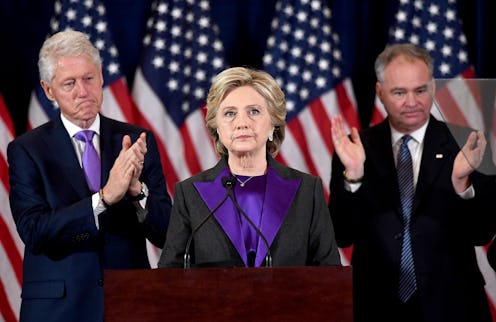News
Clinton Won The Popular Vote But She Lost
Now, all the votes haven't been counted, but it's looking pretty clear at the time of writing that Hillary Clinton won the popular vote, but lost the Electoral College. It appears 59.7 million people voted for Hillary Clinton. Just 59.5 million voted for Donald Trump, but by spreading out his win in so many different states, he still handily beat her in the Electoral College. Clinton conceded Wednesday without contesting this. There is little argument among anyone watching this election, even those most dismayed by Trump's win, that he is the legitimate president by winning according to the rules in the Constitution.
But it's nevertheless valuable to understand why that split happened, why it is that despite 200,000 more people voting for Clinton, Trump received 74 more electoral votes. For the second time in five presidential elections, the new president will come into office after more Americans voted for his opponent. When George Bush came into office in 2001 despite more Americans voting for Al Gore, it was the first time that happened without meddling by the House of Representatives. And I believe there is a reason why it happened now, why it happened in 2000, and why this strange outcome of the American political system is happening so often these days.
Clinton racked up huge margins in some of the states she won, while Trump edged out states with razor-thin victories. This is especially true with the largest states. Clinton won her three biggest states, California, New York, and Illinois with margins of 62-33, 59-37, and 55-34, respectively. Conversely, Trump won Texas, Florida, and Pennsylvania by 53-43, 49-48, and 49-48, respectively.
This is a result, more than anything, of one big factor: Clinton ran the table in big cities, and the big states all have big cities. If you look at the county-level map of where Clinton and Trump did well, it looks like a sea of red with small pockets of blue. Those pockets of blue, of course, are the cities. In the United States, there are far more people in the cities than out in the country. If this election was defined by one split, more than rich-poor, white-minority, young-old, or men-women, it was defined by the split between urban and rural America.
The urban-rural split was present in the 2008 Barack Obama victory. And it seems to have only gotten bigger in this election. It's part of a larger trend in modern America, what is often referred to as "The Big Sort," where Americans travel to areas surrounded by those most like-minded. It's caused the liberal havens of the coasts to turn even more blue, as liberals in the midwest leave their homes for the big cities, like New York, Los Angeles, and San Francisco.
The big cities are also much more diverse, which is why it was mostly the states that have fewer Muslims and illegal immigrants that voted to kick them out of places like California (which has 2,550,000 undocumented immigrants, according to 2010 data from the Pew Hispanic Center). All election, people have talked about there being two Americas. One of those Americas won the popular vote, while the other won the Electoral College.
